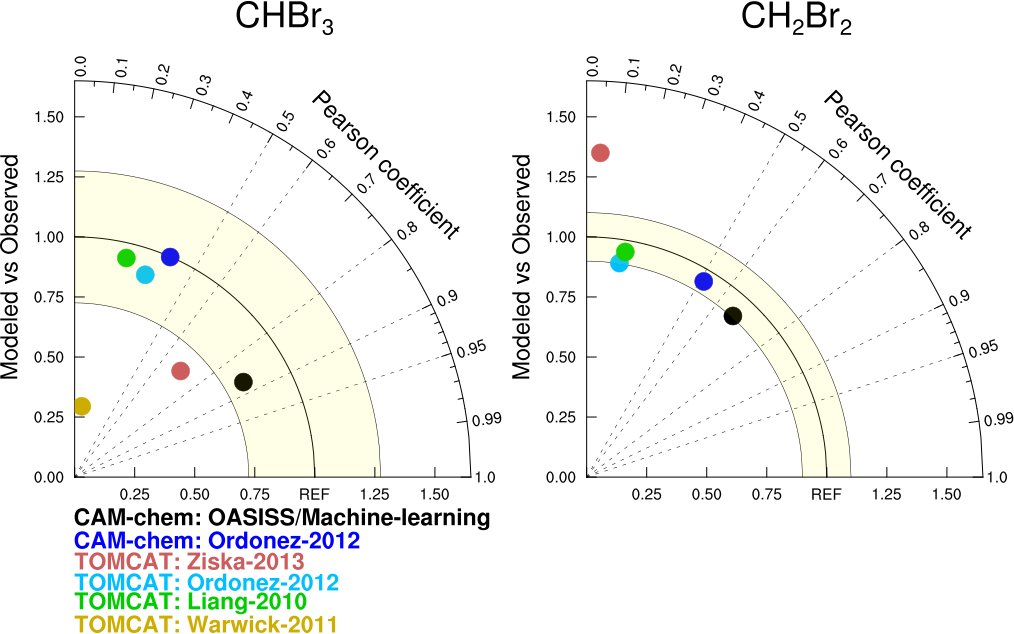Ocean biogeochemistry control on the Marine Emissions of Brominated Very Short‐Lived Ozone‐Depleting Substances
Halogen atoms released from the man‐made, long‐lived ozone‐depleting substances are the major cause of the stratospheric ozone depletion. Recent studies found that natural bromine‐containing very short lived substances are of particular importance for the ozone radiative forcing in the lower stratosphere. These short-lived organohalogens are naturally produced from phytoplankton in seawater and released into the atmosphere. Current oceanic emission inventories of these organohalogens vary dramatically.
The past decade has seen increased applications of machine‐learning techniques in climate‐related research. In this work, a data‐oriented machine‐learning algorithm is developed, leveraging the surface seawater observations of these short-lived organohalogens from previous ship-borne field campaigns.1 This machine-learning framework is coupled to the recently developed Online Air-Sea Interface for Soluble Species (OASISS) in CESM2,2,3 to calculate the production of these organohalogens in the ocean. The modeling results are evaluated using the NOAA/ESRL global surface monitoring network and the airborne observations from the NASA ATom field campaign.

Figure 1. Taylor diagrams showing the modeled surface atmospheric CHBr3 and CH2Br2 from different models compared to the surface observations, across all 14 stations in the NOAA/ESRL global surface monitoring network. The yellow shading indicates the standard deviation of all observations, and the Pearson coefficient represents the combined temporal/spatial variation.
Overall, the new oceanic emission framework is more skillful in reproducing the seasonal and vertical distributions of these short-lived organohalogens compared to the widely used top‐down approaches (Figure 1). The ocean biogeochemistry control on the synthesis of the organohalogens in the seawater is captured by the machine‐learning emulator, and the performance can be further improved once more seawater concentration observations become available. This new framework, calibrated by present‐day observations (surface seawater and atmosphere), can be used to investigate the future and past oceanic emissions of Br‐VSLS under different climate scenarios. Last but not least, we show that this machine‐learning emulator provides a fairly accurate, while computationally inexpensive, alternative (compared to a detailed marine ecosystem model) for chemistry‐climate models for representing the air‐sea exchange of other climate‐relevant trace gases, such as acetone,4 dimethyl sulfide,2 and nitrous oxide.
References
-
Wang, S., Kinnison, D., Montzka, S. A., Apel, E. C., Hornbrook, R. S., Hills, A. J., Blake, D. R., Barletta, B., Meinardi, S., Sweeney, C., Moore, F., Long, M., Saiz‐Lopez, A., Fernandez, R. P., Tilmes, S., Emmons, L. K., Lamarque, J-F. (2019). Ocean Biogeochemistry Control on the Marine Emissions of Brominated Very Short‐Lived Ozone‐Depleting Substances: A Machine‐Learning Approach. Journal of Geophysical Research - Atmospheres, 124, 12319– 12339. https://doi.org/10.1029/2019JD031288
-
Online Air-Sea Interface for Soluble Species (OASISS) for CESM2. https://wiki.ucar.edu/pages/viewpage.action?pageId=358319521
-
Wang, S., Hornbrook, R. S., Hills, A., Emmons, L. K., Tilmes, S., Lamarque, J.‐F., et al ( 2019). Atmospheric Acetaldehyde: Importance of Air‐Sea Exchange and a Missing Source in the Remote Troposphere. Geophysical Research Letters, 46. https://doi.org/10.1029/2019GL082034
-
Wang, S., Apel, E. C., Schwantes, R. H., Bates, K. H., Jacob, D. J., Fischer, E. V., et al. (2020). Global Atmospheric Budget of Acetone: Air‐Sea Exchange and the Contribution to Hydroxyl Radicals. Journal of Geophysical Research: Atmospheres, 125, e2020JD032553. https://doi.org/10.1029/2020JD032553
Contact
Please direct questions/comments about this page to: